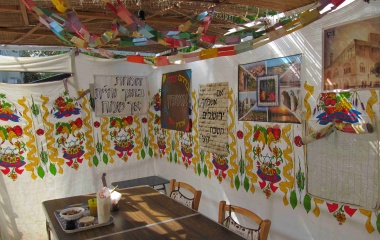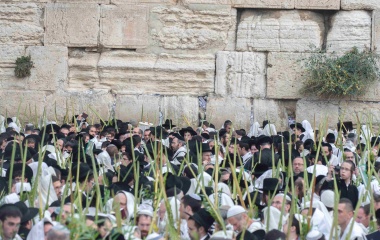The Gemara derives the minimum height of a sukkah from two separate and very distinct sources. In fact, the first “source” is no source at all. Rather it is based on simple logic. A sukkah less than ten tefachim, handbreadths (approximately three feet) tall is not fit for habitation as “it is a dira serucha, a smelly dwelling, and a person does not live in a smelly dwelling” (Sukkah 4a). No textual support is cited, as none is needed.
Less than a page later, the Gemara (ibid 4b) asks how we know that a sukkah must be at least ten tefachim tall. Here, the answer is much different, with the Gemara quoting a Biblical verse to demonstrate the minimum height needed for a sukkah. The Gemara explains that the dimensions of the aron kodesh, the Holy Ark in the Mishkan, measured 2.5 cubits long by 1.5 cubits wide by 1.5 cubits high. With six handbreadths to a cubit, the ark was nine handbreadths tall. The Gemara continues with a relatively long discussion demonstrating that the thickness of the kaporet, the covering that adorned the ark, was one handbreadth thick for a total of ten tefachim.
What is left unexplained is why we should derive the height of the sukkah from the height of the aron. It is hard to think of two abodes more different from each other than the sukkah and the aron. The sukkah is made of the flimsiest material, and its roof must be made of leftover straw and the like. One can even construct a sukkah with four poles and no walls[1]. The sukkah is designed so that “all inhabitants of Israel will dwell in the sukkah”. We are meant to invite guests to our sukkah, a notion symbolized by our inviting the Ushpizin to join our more temporal guests in the sukkah. We are encouraged and obligated to use the sukkah for the most mundane of activities; eating, sleeping, strolling and schmoozing. The more time we spend there, the better.
On the other hand, the aron is made of solid wood, encased inside and out with pure gold. Atop its solid structure is a most beautiful cover, made of the finest of linen. The aron was housed in the Kodesh HaKodashim, the Holy of Holies, where only the Kohen Gadol could enter; and even he was only permitted to enter once a year, on Yom Kippur. Only the most holy of activities could be done there: sprinkling the blood of the special Yom Kippur sacrifices, offering incense, and reciting a short prayer. He spent as little time there as possible, “and he would not lengthen his prayer so as not to make the people nervous” (Yoma 52b).
Is the sukkah meant to mimic the most basic of habitats or the most sublime? This seems to be at the center of the debate between Rabbi Eliezer and Rabbi Akiva regarding the nature of the sukkah. Is it reminiscent of the simple huts the Jews lived in during their desert wandering, or is our sukkah a reminder of the Divine clouds of glory that led us on our way?
Just as our ancestors both lived in huts and were guided by the clouds of glory, our sukkah is simultaneously the most basic and the most holy of structures. We need not build a sanctuary to get close to G-d. Judaism sees holiness in the most mundane of activities. There is a place for physical beauty, pageantry, and the like; but day to day, the way to reach G-d is through the mundane. In the case of the original Torah society, we sanctified the mundane through the many mitzvot associated with farming. For us, it might be real estate, investment banking, or the law that we must imbue with holiness, turning our working hours into vehicles for divine worship.
Our sukkah must be at least ten handbreadths tall not just so it won’t be a dira serucha, but so it can be a holy ark.
[1] How such is done is beyond the scope of this devar Torah. Please G-d we will have the opportunity to discuss the various ways to build a sukkah with the smallest of walls.



